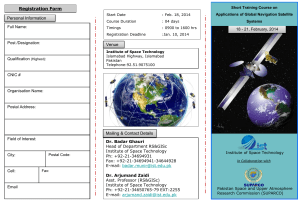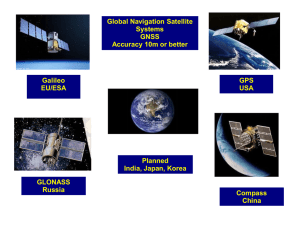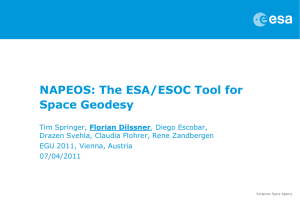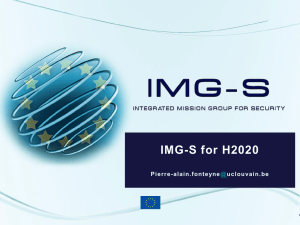Sherpa UF - European GNSS Agency
advertisement
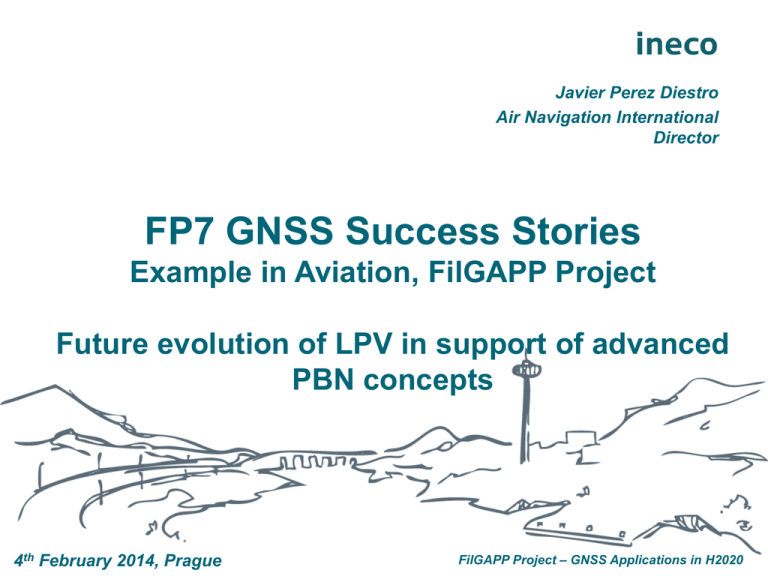
Javier Perez Diestro Air Navigation International Director FP7 GNSS Success Stories Example in Aviation, FilGAPP Project Future evolution of LPV in support of advanced PBN concepts 4th February 2014, Prague FilGAPP Project – GNSS Applications in H2020 ingeniería y consultoría de transporte transport engineering and consultancy Contents • Where we are in aviation using GNSS… • Background • Successful LPV publication in Europe • Users’ requests • Where we want to ‘fly’ in aviation using GNSS as enabler • End users demand Advanced procedures and operations • FilGAPP Project • Conclusions Prague, 4 February 2014 FilGAPP Project – GNSS Applications in H2020 2 ingeniería y consultoría de transporte transport engineering and consultancy Background • Resolution made at the ICAO 36th & 37th General Assembly • European States plan the implementation of APV/SBAS (LPV) procedures to all instrument runway-ends, based on SBAS, EGNOS in Europe. • Projects launched and supported by EC/GSA to implement procedures & operations based on European GNSS systems Pre-operational projects (trials & support) Operational projects (publication/certification & advanced procedures) • European Satellite Service Provider • EGNOS SoL service declared operational on the 2nd of March 2011 • LPV operational implementation on its way in Europe: • More than 73 LPV & 74 APV Baro published. Prague, 4 February 2014 FilGAPP Project – GNSS Applications in H2020 3 ingeniería y consultoría de transporte transport engineering and consultancy Issues/gaps to be addressed. Users’ requests • End users are demanding new operations to improve and achieve the following benefits and make use of capabilities already available onboard: • Efficiency and operational benefits • More stabilised final segment approach, reduction of missed approaches • Decongest TMA, new operations in RWYs not equipped with ILS or terrestrial navaids • Precision departures: reduction of departure climb gradient • Cost Efficiency • Reduction of flying time / fuel consumption -> better service / cost saving for operators • Reduction of terrestrial equipment maintenance -> cost saving for ANSPs • Low cost GNSS sensors with high performance • Environmental benefits: Reduction of noise and emissions • Implementing new operations based on new nav.specs. (ICAO doc. 9613) • RNP curved arrivals/approaches, A-RNP, RNP APCH (LPV), RNP AR, RNP 1, etc. • RF legs prior to FAP, Advanced operations • Increase safety with these new operations • These gaps will be addressed in the FilGAPP Project using GNSS as key positioning / time enabler Prague, 4 February 2014 FilGAPP Project – GNSS Applications in H2020 4 Assisted by: FilGAPP Project “Filling the gap” in GNSS Advanced Procedures and oPerations Galileo, 7th Framework Programme http://filgapp.ineco.es filgapp@ineco.es ingeniería y consultoría de transporte transport engineering and consultancy Project Objectives: Users demands • The purpose of FilGAPP is the stimulation, development and demonstration of innovative advanced operations, procedures and applications based on GNSS • Operations incorporating curved segments in arrivals – Advanced RNP (A-RNP) and RNP AR APCH navigation specification – RF (radius to fix) legs functionality – Curved arrivals with final transition to LPV enabled by GNSS • Development of Advanced time-based operations – Precision departures and 4D concept • Advanced GNSS Flight Trials: Germany and Spain • Consistent with ICAO and Eurocontrol strategies – Paving the way for implementation of GNSS Advanced RNP, RNP AR APCH and RNP APCH (LPV) operations in Europe Prague, 4 February 2014 FilGAPP Project – GNSS Applications in H2020 6 ingeniería y consultoría de transporte transport engineering and consultancy FilGAPP Consortium Coordinator and technical consultancy ANSPs & Airports Airlines (Regional & Business Aviation) Avionics Manufacturer Research Institutes Technical and operational consultancy Prague, 4 February 2014 FilGAPP Project – GNSS Applications in H2020 7 ingeniería y consultoría de transporte transport engineering and consultancy FilGAPP activities Prague, 4 February 2014 FilGAPP Project – GNSS Applications in H2020 8 ingeniería y consultoría de transporte transport engineering and consultancy FILGAPP: Spanish scenario #1 • Location: Valencia airport, Spain • Aircraft model/operator: CRJ-1000NG / Air Nostrum • Scenario characteristics: Noise restrictions • Expected date: Q1 2014 • Demonstration objectives: – Curved departure for RWY 12 – Curved approach (RF leg) prior to FAP and final transition to LPV RWY30 Prague, 4 February 2014 FilGAPP Project – GNSS Applications in H2020 9 ingeniería y consultoría de transporte transport engineering and consultancy FILGAPP: Spanish scenario #2 • Location: Pamplona airport, Spain • Aircraft model/operator: CRJ-1000NG / Air Nostrum • Scenario characteristics: Difficult terrain environment • Expected date: Q1 2014 • Demonstration objectives: – Reduction of approach minima (LPV to non ILS RWY 33) – More stabilised final segment approach – Reduction of departure climb gradient RWY15 Prague, 4 February 2014 FilGAPP Project – GNSS Applications in H2020 10 ingeniería y consultoría de transporte transport engineering and consultancy FILGAPP: German scenario #1 • Location: Egelsbach airport, Germany • Aircraft model/operator: Hawker 750/ NetJets • Scenario characteristics: Airspace restrictions • Expected date: End 2013 – Q1 2014 • Demonstration objectives: – IFR procedures with lower minima – Advanced RNP with transition to LPV (RWY 27) • RF prior to FAF transition to RNP APCH – Decongest Frankfurt area Prague, 4 February 2014 FilGAPP Project – GNSS Applications in H2020 11 ingeniería y consultoría de transporte transport engineering and consultancy FILGAPP: German scenario #2 • Location: Saarbrücken airport, Germany • Aircraft model/operator: Cessna 340 / NavArt • Scenario characteristics: Noise restrictions, terrain limitations (border) • Expected date: End 2013 – Q1 2014 • Demonstration objectives: – Assessment and introduction of RF legs prior to FAF with transition to LPV Prague, 4 February 2014 FilGAPP Project – GNSS Applications in H2020 12 ingeniería y consultoría de transporte transport engineering and consultancy Conclusions • LPV is now a reality in Europe. • End users are demanding new operations using GNSS as enabler. – Curved approaches with RF prior to FAP and final transition to LPV. • Operators have to be equipped with SBAS capability. • ANSPs and Airports have to implement these operations. – EC/GSA is supporting these activities (Sherpa, ACCEPTA, …). • FilGAPP Project will demonstrate the benefits provided by these advanced operations through different flight trials. – In Spain: Valencia and Pamplona – In Germany. Egelsbach and Saarbrücken Prague, 4 February 2014 FilGAPP Project – GNSS Applications in H2020 13 ingeniería y consultoría de transporte transport engineering and consultancy Relationship with SESAR activities • The FilGAPP project complements SESAR activities: • • • • • SESAR P 4.7.2, “Separation task en-route trajectory based environment” SESAR P 4.7.3, “Use of PBN for En Route Separation Purposes” SESAR P 5.6.2, “Improving vertical profiles” SESAR P 5.6.3, “Approach Procedure with Vertical Guidance (APV)” SESAR P 5.7.2 “Development of 4D Trajectory-Based Operations for separation management using RNAV/PRNAV” • SESAR Work Package 9 (Aircraft Systems), sub item “Terminal & Approach Operations” ‒ SESAR SWP 9.9 analyses the A/C system architecture to enable RNP transition to XLS ‒ SESAR SWP 9.10 is focused on “APV avionics” Prague, 4 February 2014 FilGAPP Project – GNSS Applications in H2020 14 ingeniería y consultoría de transporte transport engineering and consultancy . Thank you very much for your attention! Questions? Javier Perez Diestro Air Navigation International Director Prague, 4 February 2014 FilGAPP Project – GNSS Applications in H2020 15
